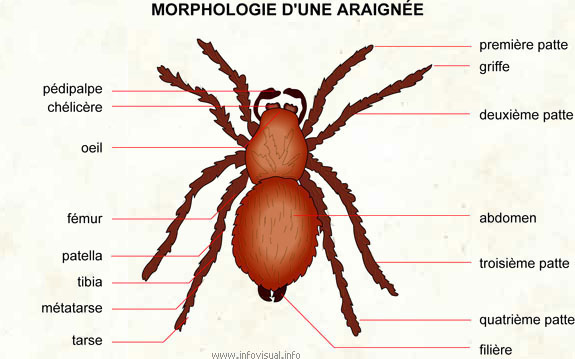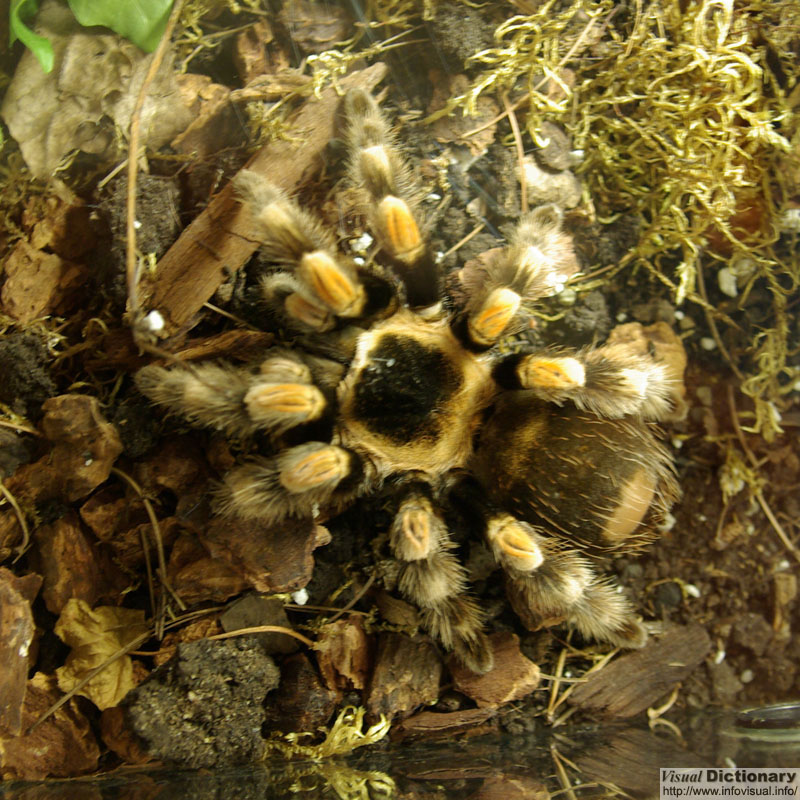Araignée

Première patte: premier membre locomoteur de l'airaignée à partir de sa tête.
Griffe: ongle pointu de l'araignée.
Deuxième patte: deuxième membre locomoteur.
Abdomen: partie postérieure du corps de l'araignée.
Troisième patte: troisième membre locomoteur.
Quatrième patte: quatrième membre locomoteur.
Filière: ouverture par laquelle l'araignée émet ses fils.
Tarse: dernière partie de la patte de l'araignée.
Métatarse: quatrième partie de la patte.
Tibia: troisième partie de la patte.
Patella: deuxième partie de la patte.
Fémur: première partie de la patte.
Oeil: organe visuel de l'araignée.
Chélicère: crochet pair, venimeux, situé sur la tête.
Pédipalpe: pied tactile.
Photo :

Arachnid may be easily distinguished from insect by the fact that arachnid have 8 legs whereas insects have 6. Arachnid are a class achnida. They are terrestrial arthropods species including spiders, scorpions, harvestmen, ticks, and mites. Arachnids are further distinguished by the fact they have no antennae and no wings. Their body is organized into two tagma called the prosoma, or cephalothorax, and the opisthosoma, or abdomen. The cephalothorax (prosoma) is derived from the fusion of the cephalon (head) and the thorax. The abdomen (opisthosoma) can be further divided into the preabdomen and postabdomen in many taxa, although in some orders such as the Acari the abdominal sections are fused.
There are some important modifications that are particularly important for the terrestrial lifestyle of an arachnid, such as internal respiratory surfaces in the form of trachea, or modification of the book gill into a book lung, an internal series of vascular lamellae used for gas exchange with the air. Further adaptations are appendages modified for more efficient locomotion on land, internal fertilisation, special sensory organs, and water conservation enhanced by more efficient excretory structures (coxal glands and Malpighian tubules) as well as a waxy layer covering the cuticle.
Arachnids are mostly carnivorous, feeding on the pre-digested bodies of insects and other small animals. Only in the harvestmen and among mites, such as the house dust mite, is there ingestion of solid food particles and thus exposure to internal parasites, althougth it is not unusual for spider to eat their own silk. Several groups are largely venomous - they secrete venom from specialized glands to kill prey or enemies. Several mites are parasites, some of which are carriers of disease. Arachnids usually lay eggs, which hatch into immatures that resemble adults, but scorpions bear live young.
Animation : Theraphosidae
Merci à YouTube de nous permettre d'observer ce vidéo.